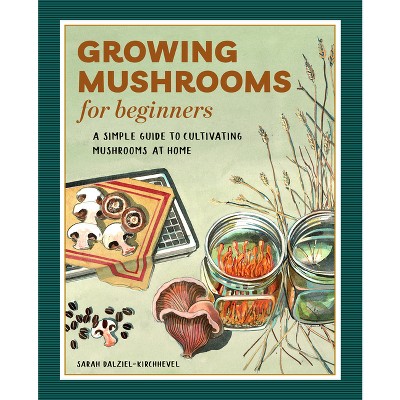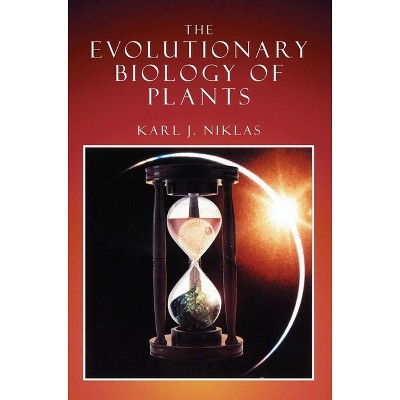Sponsored

Plant Physics - by Karl J Niklas & Hanns-Christof Spatz (Paperback)
$43.99Save $2.01 (4% off)
In Stock
Eligible for registries and wish lists
Sponsored
About this item
Highlights
- From Galileo, who used the hollow stalks of grass to demonstrate the idea that peripherally located construction materials provide most of the resistance to bending forces, to Leonardo da Vinci, whose illustrations of the parachute are alleged to be based on his study of the dandelion's pappus and the maple tree's samara, many of our greatest physicists, mathematicians, and engineers have learned much from studying plants.
- About the Author: Karl J. Niklas is the Liberty Hyde Bailey Professor of Plant Biology in the Department of Plant Biology at Cornell University.
- 448 Pages
- Science, Life Sciences
Description
About the Book
For centuries, botanists and physicists have mutually benefitted from collaborations. Galileo used the hollow stalks of grass to illustrate the idea that peripheral rather than centrally located construction materials provide most of the resistance to bending forces. Leonardo da Vinci s interest in fluid mechanics was inspired by observing the cross-sectional areas of tree trunks, and his drawings illustrating the concept of a parachute and an auto-gyroscopic propeller are alleged to be based on his study of the dandelion s pappus and the maple tree s samara."Plant Physics"explores the contemporary insights that emerge when plants are studied with the aid of physics, mathematics, engineering, and chemistry. It starts with such fundamental topics as the importance of plant life, the relationship between organic form and function, plant reproduction and development, the importance of multicellularity, and the developmental basis of the basic plant body plans. The work then explores how fundamental physical principles and processes affect plant growth and ecology. Specific topics addressed include plant water relations, solid and fluid mechanics, electrophysiology, and optics in relation to plant form, function, and ecology.
Written by one of the world s best known botanists, it is destined to inspire students and professionals alike to traverse disciplinary membranes."
Book Synopsis
From Galileo, who used the hollow stalks of grass to demonstrate the idea that peripherally located construction materials provide most of the resistance to bending forces, to Leonardo da Vinci, whose illustrations of the parachute are alleged to be based on his study of the dandelion's pappus and the maple tree's samara, many of our greatest physicists, mathematicians, and engineers have learned much from studying plants.
A symbiotic relationship between botany and the fields of physics, mathematics, engineering, and chemistry continues today, as is revealed in Plant Physics. The result of a long-term collaboration between plant evolutionary biologist Karl J. Niklas and physicist Hanns-Christof Spatz, Plant Physics presents a detailed account of the principles of classical physics, evolutionary theory, and plant biology in order to explain the complex interrelationships among plant form, function, environment, and evolutionary history. Covering a wide range of topics-from the development and evolution of the basic plant body and the ecology of aquatic unicellular plants to mathematical treatments of light attenuation through tree canopies and the movement of water through plants' roots, stems, and leaves-Plant Physics is destined to inspire students and professionals alike to traverse disciplinary membranes.
Review Quotes
"Brilliant. . . . This is truly a lovely book."-- "Plant Science Bulletin"
"Here's the physical world of plants in all its splendor--and multidimensionality--brought to bear on the rich diversity of both extant and extinct forms. Niklas and Spatz's theme, which deserves attention, is that since plants (and animals, of course) cannot change physics, physical laws and processes must bear strongly on the course of their evolution."--Steven Vogel, Duke University
"Karl J. Niklas and Hanns-Christof Spatz have written a remarkable book, unique in the field of biomechanics. Starting from basic physical principles, it explains a wide range of phenomena in plants, from fluid transport to the dispersal of seeds in air and water to structural behavior. The experimental and theoretical tools described provide a useful primer. A valuable reference for researchers interested in how plants work from a physical perspective."--Lorna Gibson, Massachusetts Institute of Technology
"[Plant Physics] will inspire and interest as well as provide a rock solid foundation for further study."--R. S. Shorter, Winchester College "Contemporary Physics"
"[A]n interesting interdisciplinary glimpse into the physics of plant biology. . . . A useful resource for advanced courses in botany, plant physiology, and biophysics. Recommended."--J. Z. Kiss, Miami University "Choice"
"A significant addition to the literature on plant structure. Plant Physics presents a comprehensive overview of the physics relevant to the structural economy of land plants. . . . For the plant biologist, this book will be an invaluable reference for many years. For the physicist, the attraction of this book may be the breadth of topics covered and the implication that physics lies at the very heart of plant developmental biology."--Philip Lintilhac, University of Vermont, Burlington "BioScience"
"There is no better way to learn about plants than studying physics and to learn physics than studying plants. This book does just so. In a comprehensive but not overwhelming manner, the authors provide an overview of carefully selected topics that beautifully link descriptions of plant physiological and cellular activity with explanations of the physical forces that shape plant structure and function. . . . I enjoyed reading this volume and would recommend it as a valuable addition to the bookshelves in all plant biology or physics graduate rooms and for all plant biology or physics teachers."--Maciej Zwieniecki, Harvard University "Quarterly Review of Biology"
About the Author
Karl J. Niklas is the Liberty Hyde Bailey Professor of Plant Biology in the Department of Plant Biology at Cornell University. He is the author of Plant Biomechanics, Plant Allometry, and The Evolutionary Biology of Plants, all published by the University of Chicago Press. Hanns-Christof Spatz is professor emeritus of biophysics in the Faculty of Biology at the Albert-Ludwigs-Universität Freiburg in Germany.Dimensions (Overall): 9.0 Inches (H) x 6.09 Inches (W) x .96 Inches (D)
Weight: 1.3 Pounds
Suggested Age: 22 Years and Up
Number of Pages: 448
Genre: Science
Sub-Genre: Life Sciences
Publisher: University of Chicago Press
Theme: Botany
Format: Paperback
Author: Karl J Niklas & Hanns-Christof Spatz
Language: English
Street Date: February 4, 2014
TCIN: 1006093002
UPC: 9780226150819
Item Number (DPCI): 247-31-8574
Origin: Made in the USA or Imported
If the item details aren’t accurate or complete, we want to know about it.
Shipping details
Estimated ship dimensions: 0.96 inches length x 6.09 inches width x 9 inches height
Estimated ship weight: 1.3 pounds
We regret that this item cannot be shipped to PO Boxes.
This item cannot be shipped to the following locations: American Samoa (see also separate entry under AS), Guam (see also separate entry under GU), Northern Mariana Islands, Puerto Rico (see also separate entry under PR), United States Minor Outlying Islands, Virgin Islands, U.S., APO/FPO
Return details
This item can be returned to any Target store or Target.com.
This item must be returned within 90 days of the date it was purchased in store, shipped, delivered by a Shipt shopper, or made ready for pickup.
See the return policy for complete information.
Frequently bought together

$8.49
MSRP $14.99
Buy 1, get 1 50% off select books
2 out of 5 stars with 1 ratings
Trending Non-Fiction

$15.68
Buy 1, get 1 50% off select books
4.8 out of 5 stars with 207 ratings

Highly rated
$19.31
was $20.98 New lower price
Buy 1, get 1 50% off select books
3.9 out of 5 stars with 71 ratings

$18.28
was $19.58 New lower price
Buy 1, get 1 50% off select books
4.7 out of 5 stars with 17 ratings

$4.59
MSRP $7.99
Buy 1, get 1 50% off select books
4.8 out of 5 stars with 125 ratings

$6.20
MSRP $10.95
Buy 1, get 1 50% off select books
4.8 out of 5 stars with 33 ratings

$7.09
MSRP $9.99
Buy 1, get 1 50% off select books
4.9 out of 5 stars with 46 ratings










